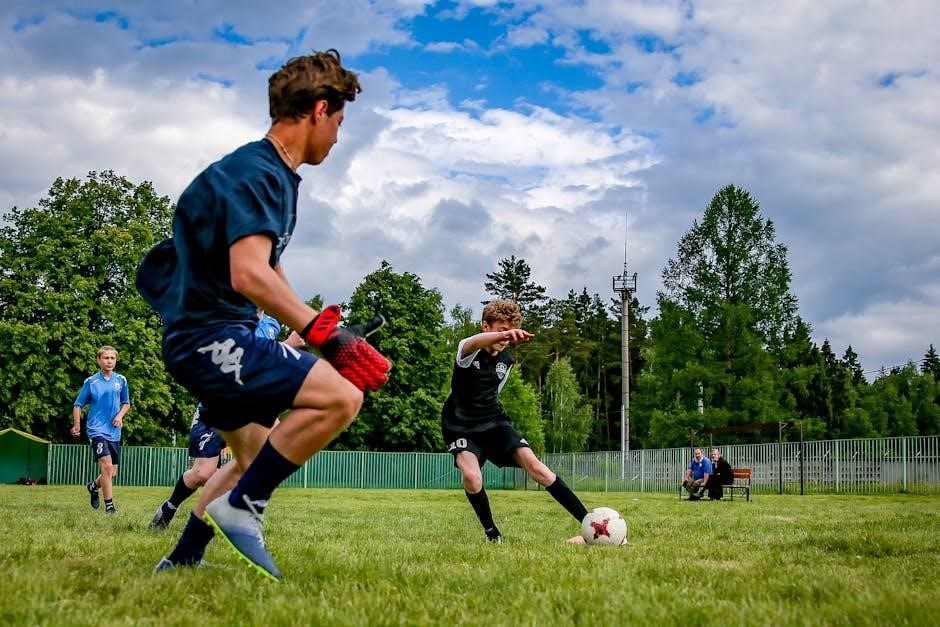A youth football defensive playbook is an essential guide for coaches‚ detailing strategies‚ formations‚ and drills to build a strong‚ assignment-based defense. It includes proven schemes like the 5-3‚ 6-2‚ and 4-4 defenses‚ along with blitz packages and coverage techniques. A well-structured playbook helps young players develop fundamental skills‚ ensuring a solid defensive foundation for all skill levels.
Overview of Defensive Strategies in Youth Football
Defensive strategies in youth football focus on stopping the opponent’s offense while teaching fundamental skills. Key approaches include base formations like the 5-3‚ 6-2‚ and 4-4‚ which provide structure and assignments for players. Blitz packages and coverage schemes‚ such as man-to-man and zone coverage‚ add flexibility and pressure. These strategies emphasize teamwork‚ discipline‚ and adaptability‚ allowing coaches to tailor defenses to their team’s strengths and the opponent’s weaknesses. By combining physical techniques with mental awareness‚ young players learn to anticipate plays and react effectively. A well-executed defense builds confidence and enhances overall team performance‚ making it a cornerstone of successful youth football programs.

Importance of a Well-Structured Defensive Playbook for Youth Teams
A well-structured defensive playbook is crucial for youth football teams as it provides clear assignments and strategies‚ helping players understand their roles. It teaches fundamental skills like tackling‚ footwork‚ and coverage‚ building a strong defensive foundation. A playbook fosters teamwork‚ discipline‚ and confidence‚ allowing players to execute plays effectively. It also offers flexibility‚ enabling coaches to adapt to various opponents and game situations. By using proven formations and schemes‚ a playbook ensures consistency and improves overall performance. Ultimately‚ it serves as a valuable tool for coaches to develop young athletes into skilled‚ strategic defenders.

Key Defensive Formations for Youth Football
Popular defensive formations include the 5-3‚ 6-2‚ and 4-4 setups‚ each offering unique strengths. These formations are foundational for building a versatile and effective defense in youth football.
The 5-3 Defense: Base Formation and Variations
The 5-3 defense is a popular and effective formation in youth football‚ featuring five defensive linemen and three linebackers. The base formation includes a nose guard‚ two defensive tackles‚ two defensive ends‚ and three linebackers; This setup provides strong run defense and simplicity for young players. Variations include slanting the defensive line to create gaps or blitzing linebackers to pressure the quarterback. The 5-3 is highly adaptable‚ allowing coaches to adjust based on the offense’s alignment. Its simplicity makes it ideal for teaching fundamental defensive concepts‚ while its flexibility keeps offenses guessing. This formation is a cornerstone of many youth defensive playbooks due to its balance and effectiveness.
The 6-2 Defense: Tight‚ Split‚ and Wide Tackle Alignments
The 6-2 defense is another versatile formation in youth football‚ utilizing six defensive linemen and two linebackers. The tight alignment positions linemen close to the center‚ ideal for stopping runs. The split alignment spaces linemen wider‚ blending run defense with pass rush capability. The wide tackle alignment places linemen further out‚ emphasizing speed and agility. This formation is effective against teams with strong running games‚ as it overloadsthe line of scrimmage. Coaches can adjust alignments based on the offense’s strengths. The 6-2 is praised for its simplicity and aggressive nature‚ making it a favorite in youth football playbooks. Its variations allow for strategic flexibility‚ keeping offenses unpredictable and challenging to prepare against. This formation is a key component of many successful defensive strategies.
The 4-4 Defense: Strengths and Weaknesses
The 4-4 defense is a solid‚ all-around formation for youth football‚ featuring four defensive linemen and four linebackers. Its strength lies in its ability to stop the run and pass effectively‚ making it versatile. The formation is simple to install‚ allowing young players to focus on execution rather than complexity. It also provides strong support against both inside and outside runs. However‚ the 4-4 can struggle against spread offenses with multiple receivers‚ as it lacks an extra defensive back. Additionally‚ it requires disciplined linebackers to avoid overcommitting to plays. Overall‚ the 4-4 is a reliable choice for teams needing balance but may not excel against modern‚ pass-heavy offenses. Its adaptability makes it a popular choice in many youth football playbooks.
Blitz Packages and Pressure Schemes

Blitz packages add dynamic pressure to a defense‚ utilizing linebackers and defensive backs to disrupt the quarterback. These schemes are crucial for creating turnovers and confusion‚ while keeping offenses guessing. Effective execution requires precise timing and coordination‚ making them a powerful tool in youth football strategies.
Linebacker Blitzes: Timing and Execution
Linebacker blitzes are a cornerstone of aggressive defensive strategies‚ requiring meticulous timing and execution. Coaches should emphasize reading offensive cues‚ such as the quarterback’s stance‚ to anticipate plays. Proper footwork and angles ensure linebackers reach the quarterback quickly‚ while maintaining gap integrity prevents large gains. Drills focusing on reaction speed and coordination are essential for youth players to master these techniques. Effective communication among defenders is also crucial‚ as misalignment can lead to breakdowns. By teaching these fundamentals‚ coaches can turn linebacker blitzes into a reliable and impactful tactic in their defensive playbook.
Defensive Back Blitzes: Adding Secondary Pressure
Defensive back blitzes introduce secondary pressure‚ surprising offenses and creating chaos. Coaches must teach technique‚ such as exploding off the snap and using angles‚ to ensure effectiveness. Proper timing with linebackers is key to avoid gaps. Drills focusing on reaction and angle pursuit help execution. These blitzes diversify defensive looks‚ keeping offenses guessing. Effective communication prevents breakdowns. When executed well‚ they disrupt rhythm and force quick decisions‚ enhancing the defense’s impact. This adds versatility and unpredictability to the playbook‚ making it harder for offenses to prepare. Blitzing defensive backs can be a game-changer for youth teams‚ boosting defensive strength.
Combining Blitzes for Maximum Impact
Combining blitzes maximizes defensive pressure by mixing linebacker and defensive back blitzes. This creates unpredictability‚ forcing offenses into quick decisions. Coaches should design blitz packages that exploit weaknesses‚ ensuring timing and execution are precise. Start with basic combinations‚ then progress to complex schemes as players gain confidence. Teach players to read offensive alignments and adjust blitz angles accordingly. Drills focusing on reaction and communication are crucial for seamless execution. Rotate blitzers to keep offenses guessing‚ and align blitz paths to attack vulnerabilities. Effective blitz combinations disrupt rhythm‚ sack the quarterback‚ and inspire defensive unity. This strategic approach transforms defensive playbooks into dynamic‚ game-changing tools.
Coverage Schemes for Youth Football
Coverage schemes are fundamental to youth football defense‚ teaching players to excel in man-to-man and zone coverage. These strategies enhance defensive skills and teamwork effectively.
Man-to-Man Coverage: Assignments and Techniques
Man-to-man coverage is a cornerstone of youth football defense‚ requiring each player to guard a specific receiver. Coaches emphasize staying in position‚ mirroring movements‚ and contesting catches. Proper footwork and hand placement are crucial‚ ensuring defenders can stay tight without holding. Drills like backpedal and break-on-ball exercises improve agility and reaction time. Assignments are clear: defenders must stay disciplined‚ communicate‚ and trust their teammates. Techniques include press coverage at the line and trail techniques downfield. Simplifying assignments for younger players helps build confidence and execution. As players mature‚ they can incorporate more complex strategies‚ making man-to-man a versatile tool for all skill levels.
Zone Coverage: Teaching Concepts to Young Players
Zone coverage simplifies defense for young players by assigning each defender a specific area to protect. Coaches teach players to read the quarterback’s eyes‚ stay disciplined in their zones‚ and react to the ball. Drills like “zone drops” and “ball hawk” exercises improve awareness and reaction skills. Young athletes learn to cover flats‚ hooks‚ and deep zones while maintaining proper footwork and body positioning. Simplified terminology‚ such as “inside” or “outside” zones‚ helps players understand their roles. Zone coverage reduces complexity‚ allowing players to focus on the ball and make plays without overthinking. It fosters teamwork and trust‚ as each player relies on others to cover their assigned areas.

Building a Reliable Defense at the Youth Level
Building a reliable youth defense requires combining proven strategies‚ ensuring consistency‚ and making smart adjustments to suit your team’s strengths and opponents’ weaknesses.
Drills for Improving Tackling and Footwork
Drills focusing on tackling and footwork are fundamental to building a reliable defense. Start with head-up tackling drills to teach proper technique and safety. Use footwork ladder drills to improve agility‚ quickness‚ and reaction time. Incorporate cone drills to simulate game-like movements. Pair players for wrap-up tackling exercises‚ emphasizing form and control. Reaction drills‚ such as ball carrier pursuit‚ help defenders respond swiftly to plays. Consistent practice of these drills enhances physical skills and mental awareness‚ ensuring defenders are prepared for game situations.
Practice Plans for Installing Defensive Schemes
Effective practice plans for installing defensive schemes involve structured sessions that combine teaching‚ drills‚ and live reps. Begin with a dynamic warm-up to prepare players physically and mentally. Dedicate time to reviewing defensive assignments‚ focusing on alignment‚ gaps‚ and responsibilities. Use chalkboard or whiteboard sessions to visually reinforce concepts. Incorporate positional drills to refine techniques‚ such as tackling‚ footwork‚ and hand placement. Progress to group drills‚ like 7-on-7 or 11-on-11 scrimmages‚ to apply schemes in game-like situations. Conclude with a cool-down and review of key takeaways. Consistency‚ repetition‚ and positive reinforcement are crucial for young players to grasp and execute defensive strategies effectively.

Age-Specific Defensive Strategies
Age-specific defensive strategies tailor schemes to players’ developmental levels. For younger teams (5U-8U)‚ focus on basic alignments and simple commands. Older teams (9U-12U) can handle complex variations and blitz packages‚ enhancing versatility and effectiveness.
Defensive Playbook for 5U-8U Teams
For 5U-8U teams‚ the defensive playbook should focus on simplicity and fundamentals. Emphasize basic formations like the 5-3 and 6-2‚ teaching players to align properly and react to the ball. Introduce basic coverage concepts‚ such as man-to-man and zone coverage‚ using visual cues. Blitzing should be limited to linebacker blitzes‚ keeping it easy to execute. Drills should concentrate on tackling technique and footwork to build confidence and safety. Keep plays straightforward‚ allowing young players to grasp assignments without overwhelming them. This approach builds a strong defensive foundation‚ preparing them for more complex strategies as they progress.
Advanced Strategies for 9U-12U Teams
For 9U-12U teams‚ the defensive playbook can incorporate more advanced strategies‚ such as multiple formations like the 4-4‚ 5-3‚ and 6-2 defenses. These formations allow for flexibility and adaptation to various offensive schemes. Introduce defensive back blitzes and linebacker blitz packages to create pressure on the quarterback. Zone and man-to-man coverage schemes can be combined to confuse offenses and exploit weaknesses. Teach players to read offensive alignments and adjust accordingly. Emphasize pre-snap reads‚ gap responsibility‚ and pursuit angles. Incorporate drills that focus on tackling‚ footwork‚ and reaction time to enhance execution. These advanced strategies build on foundational skills‚ preparing teams for higher levels of competition while maintaining a focus on safety and fundamentals.
Thank you for exploring the youth football defensive playbook PDF. This guide provides essential strategies‚ formations‚ and drills to enhance your team’s defensive skills. Download free resources and advanced playbooks to further develop your coaching toolkit and elevate your team’s performance.
Free Youth Football Defensive Playbook PDF Downloads
Access comprehensive youth football defensive playbook PDFs for free‚ offering detailed strategies and drills. These resources include proven formations like the 5-3‚ 6-2‚ and 4-4 defenses‚ along with blitz packages and coverage schemes.
- Download playbooks tailored for age groups 5U-12U‚ with age-specific strategies.
- Find diagrams‚ practice plans‚ and drills to improve tackling and footwork.
- Discover advanced techniques for older teams‚ including linebacker and defensive back blitzes.
These free resources are designed to help coaches build a reliable defense and elevate their team’s performance. Download your copy today and transform your team’s defensive game!
Additional Resources for Coaches and Players
Supplement your coaching with additional resources designed to enhance your team’s defensive performance. Explore over 400 free football playbooks‚ including youth‚ high school‚ and college-level strategies.
- Discover age-specific defensive playbooks for 5U-12U teams‚ tailored to different skill levels.
- Access drills‚ diagrams‚ and practice plans to improve tackling‚ footwork‚ and coverage techniques.
- Learn from top coaches with proven defensive schemes like the 4-3‚ 5-2‚ and 6-2 formations.
- Find downloadable PDFs packed with blitz packages‚ zone and man coverage strategies‚ and game-ready tips.
These resources are perfect for both new and experienced coaches‚ offering tools to build a competitive and disciplined defense.

